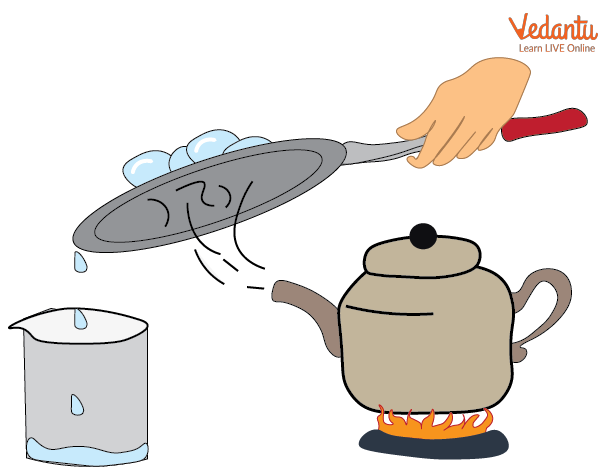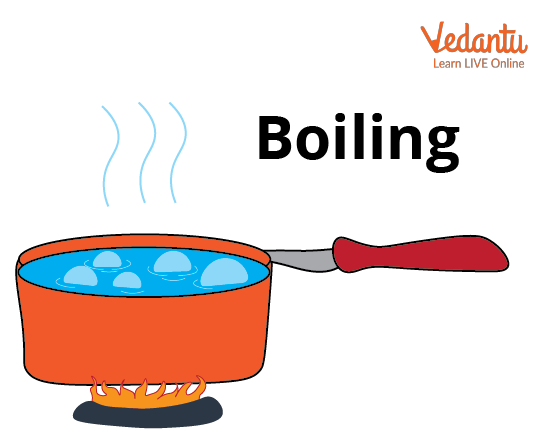




Introduction to Boiling and Condensation
Today, we will learn about boiling and condensation. Boiling is the method in which a liquid state turns into a gaseous state. Heating water into steam is the best example of understanding the boiling process. When liquid is heated, then it turns into vapour. When the liquid turns into a gas state, then more heat is required.

Boiling and Condensation
In Science, condensation is the process where water vapour turns into liquid. In this process, cooling takes place. Condensation methods are advantageous for cleaning low-flow, highly concentrated exhaust gas streams. In this article, we will learn about boiling and condensation in detail.
What is Boiling?
In Chemistry, when a liquid is heated to its boiling point, this phase change is known as boiling. It takes place by changing the liquid state into the gas state. When a liquid reaches its boiling point, then the pressure exerted on its surface by the atmosphere is equal to the liquid's vapour pressure.
Boiling is a physical transformation in which the molecules are not chemically changed. Boiling occurs when atoms or molecules in a liquid are able to fully separate from transitioning from a liquid to a gaseous state.
The temperature at which a particular liquid starts to boil is known as the boiling point. For example, water has a boiling point of 100ºC at 1 atm of pressure. A liquid's boiling point is affected by temperature, air pressure, and the liquid's vapour pressure.
Boiling occurs when the liquid's vapour pressure and air pressure are equal. The more powerful molecules become gas, spread out, and create bubbles when boiling takes place. These come to the surface and soar into the sky.

Boiling of Water
What is Condensation?
In Science, condensation is the process where water changes from its gaseous state to its liquid state.
The water cycle is a mechanism that shows how water transforms inside the Earth's atmosphere. The process of water changing from a gaseous state to a liquid state is known as condensation, which is the opposite phase of evaporation.
In the atmosphere, water exists in three states: solid, liquid, and gas. Since molecules are spread out across a large volume of space, they turn into a gas at a temperature of 100°C. Gas has a loose molecular structure. The molecular structure of the liquid, such as water, is more packed than that of gas because the molecules are packed closer together over a smaller surface area. At 20°C, the water turns liquid. Solids such as ice have extraordinarily tight molecular structures and at 0°C, water turns to ice.
Example
As the water vapour cools in the sky, clouds are created. Tiny water droplets form when the temperature of the water vapour reaches the dew point or lower. These droplets condense onto small dust particles to form clouds.
Summary
In this article, we learned that Evaporation and Condensation are two crucial steps of the water cycle. Evaporation is defined as the conversion of liquid to gas and escaping into the air whereas condensation refers to the conversion from gaseous to a liquid state. Both of the processes discussed above carry out opposite conversions of matter.
FAQs on Boiling and Condensation
1. Why are the boiling and condensation points the same in temperature?
A reversal of the action that took place at the boiling point is condensation. When a liquid reaches its boiling point, the evaporated vapours can be compressed at the same temperature to condense the vapours back into the liquid state. Therefore, the boiling point and condensation point are both at the same temperature.
2. State some applications of condensation.
Power generating, water desalination, thermal management, refrigeration, and air conditioning are a few examples of the commercial uses of condensation for both consumers and industry.
3. Why does boiling point change?
A liquid's boiling point is influenced by temperature, air pressure, and the liquid's vapour pressure. Boiling starts when the liquid's vapour pressure and air pressure are equal.
4. The temperature decreases as we rise to higher altitudes, so why wouldn't a cloud containing water turn into ice?
Lowering a liquid or gas's temperature below its freezing point without causing it to solidify is a process known as supercooling, which is also referred to as undercooling. In the absence of a seed crystal or nucleus around which a crystal structure can develop, it does this. When liquids are supercooled, they remain liquid even when their regular freezing point has been reached. High-altitude clouds are a collection of supercooled water droplets which have not frozen. They contain tiny water droplets that, in the absence of crystals, keep ice from forming in spite of the extremely low temperatures because of the process known as supercooling.





















